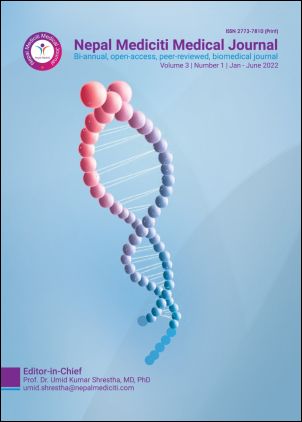Study of clinical profile and outcome of patients with snake envenomation at Bheri Hospital Nepal
DOI:
https://doi.org/10.3126/nmmj.v3i1.48524Keywords:
Snake bite, envenomation, clinical profile, outcomeAbstract
BACKGROUND Snake bite is a public health problem in terai and inner terai of Nepal. It is a medical emergency leading to significant morbidity and mortality every year. This study aims to find the clinical profile and outcome of snake bite envenomation patients in Bheri Hospital Nepalgunj.
METHODS This was a cross sectional, observational study from April 2021 to November 2021. Patients with history of snake bite and clinical features suggesting envenomation were enrolled in this study, their clinical data and outcome were recorded in Excel sheet and analyzed by SPSS 20.
RESULTS A total of 58 cases of snake envenomation was admitted and managed, out of which 3 cases expired with case fatality of 5.17%. Krait and cobra were the common snake bites in this region. 84.48% of the snake bites occur inside houses and more than half 53.44% of the patients were bitten between 12am to 6am. The most common features of envenomation were ptosis, blurring of vision, swallowing difficulty, dysphonia, neck muscle weakness, epigastric pain and salivation. Majority of cases 96.55% was given 10 vials of Anti snake venom (ASV). Only 4 patients 6.89% needed ventilator assistance.
CONCLUSION Mortality with snake bites can be minimized by strengthening the treatment centers and readily availability of ASV at such centers. Public awareness about snake bite, first aid, rapid transport to health facilities would be the key to success in reducing morbidity and mortality.
Downloads
Downloads
Published
How to Cite
Issue
Section
License
Copyright (c) 2022 Nepal Mediciti Medical Journal

This work is licensed under a Creative Commons Attribution 4.0 International License.
This license enables reusers to distribute, remix, adapt, and build upon the material in any medium or format, so long as attribution is given to the creator. The license allows for commercial use.

